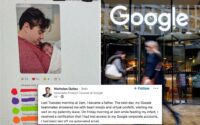Retailers busting thieves with facial-recognition tech used at MSG
James Dolan has lately stirred controversy over his use of facial-recognition technology to keep his enemies out of Madison Square Garden — but supermarkets and other retailers say they’ve begun using it for a legitimate purpose: to bust shoplifters.
Grocery stores, drug chains and other mass merchants are increasingly using high-tech innovations — including facial-recognition software, artificial intelligence and even aisle-roving robots — to clamp down on thieves. Some say they have turned up a few surprises.
Moe Issa, who owns four Brooklyn Fare stores in Manhattan and Brooklyn, said well-heeled customers with large diamond rings and Gucci bags are squirreling containers of blueberries into their purses — and said one serial offender turned out to be a mom.
“She took two organic chicken breasts and put it underneath her baby in a stroller,” Issa told The Post. “She put it under her baby’s diaper. Who is going to say, ‘Lift your baby up’?”

Retailers who are losing thousands of dollars each week to brazen thieves are turning to new technology that can alert staff when their stuff is getting pinched. While Dolan came under fire for using it to prevent his legal enemies from attending sporting events or seeing the Rockettes, retailers say their business is at stake — particularly in New York City where lax law enforcement has helped spur a shoplifting epidemic.
On Friday, an analysis of police data by The Post showed that retail thefts hit record levels for the second year in a row in 2022. Shoplifting complaints surged to more than 63,000 last year — a 45% jump over the roughly 45,0000 reported in 2021 and a nearly 275% jump compared to the mid-2000s, the statistics show.

One Bronx-based grocer who has been battling crime in his stores installed facial recognition software in one location within the past month – and says it can identify known thieves even when they try to obscure themselves with face masks and hoodies, he said.
“We have been building a file of repeat offenders and it’s incredibly efficient,” the grocer said.
Nevertheless, the grocer did not want to be identified, saying he’s concerned that facial recognition software will soon be restricted in New York as it has been in about two dozen states and cities in the US.
Big chain stores, meanwhile, are wary of exposing employees and customers to potentially violent or aggressive perpetrators. Walgreens instructs its security guards not confront thieves, as The Post previously reported. The guards are “not there to protect the product,” Joseph Stein, director of asset protection solutions for Walgreens, said at an “Anti-Crime Summit” in January.
Instead, goods at big drug chains increasingly are getting locked up, requiring customers to request assistance when buying everything from aspirin to shampoo.

As an alternative, Knightscope of Moutainview, Calif. Is peddling 4.5-foot, 400-pound robots that are equipped with cameras and can patrol store aisles or be stationed where “highly sought after items are stocked,” said spokesperson Stacy Stephens.
“The No. 1 thing is deterrence because we know that having a robot in place with security markings gets people’s attention,” he said.
Stephens would not disclose Knightscope’s retail clients, but said the robots have been deployed in shopping malls and parking lots. They rent for about 75 cents an hour and allow security personnel to open communication with a potential troublemaker.
A security staffer might talk through the robot to say, “Hey you — in the blue shirt, what are doing by the trash dumpster? This is a restricted area,” according to Stephens.

Paris-based artificial-intelligence company Veesion boasts US-based customers including ACE Hardware, Keyfood and independent liquor stores. Its systems can flag thieves when they stash goods in their clothing or in a bag, or even start drinking and eating stuff off the shelves.
Using a store’s security cameras, the software — which costs between $200 and $800 a month, depending on the size of the store — can promptly send a seven-second GIF to employees’ phones showing the thief in action.
“It took us two years to get to the point where the software can recognize the gestures and the movements of the clients inside the store,” Sean Ward, Veesion’s US manager.
Still, many say technology will only go so far to address the shoplifting epidemic. Even tech executives concede the limitations of their products.
“It’s up to the staff to take action and do something,” says Scott Mullins, founder of Irvine, Calif.-based Raptor Vision, an AI software provider that serves some Kroger and Albertsons supermarkets as well as wine stores.

Launched in June, Raptor detects suspicious behavior using a store’s security camera system, for example flagging customers who grab unusual quantities of a single product, Mullins said. The patented software alerts staff via text messages or emails within seconds.
“They have to touch the product more times than normal,” to trigger a notification, Mullins said, adding that Raptor can also activate a speaker in the aisle that can be programmed to say among other things “customer service is on its way immediately to help you.”
Westside Market agreed to test Raptor in one of its seven Manhattan stores in the next couple of weeks, the upscale grocer’s chief operating officer Ian Joskowitz told The Post.
“Raptor is perfect for a certain type of shoplifter who comes in and steals 20 steaks or 15 Haagen Dazs pints,” Joskowitz said, adding that he expects to lay out about $2,500 for the software plus a nominal monthly fee.
Westside also just hired an imposing security guard who is a mixed martial arts expert to accompany the staff at the West End location when they confront someone who is stealing from the store. The security guard wears a bulletproof vest.
“I had a woman try to stab me with a hypordermic needle,” Joskowitz said.

Not everyone, however, is embracing the new technology. Industry executives note that supermarketsin particular carry razor-thin margins, making big investments in software a tough call.
“We just had our worst year, so there is no room to make speculative investments on technology,” said Sal Bonavita, who owns two KeyFood stores in the Bronx. “The best defense we have is our employees who know when someone has tried to steal from us.”


